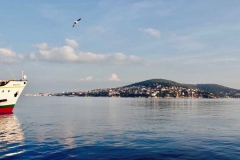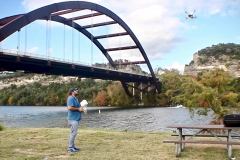Flight controls
Flight control is one of the lower-layer system and is similar to manned aviation: plane flight dynamics, control and automation, helicopter flight dynamics and controls and multi-rotor flight dynamics were researched long before the rise of UAVs.
Automatic flight involves multiple levels of priority.
UAVs can be programmed to perform aggressive maneuvers or landing/perching on inclined surfaces, and then to climb toward better communication spots. Some UAVs can control flight with varying flight modelisation, such as VTOL designs.
UAVs can also implement perching on a flat vertical surface.
Communications
Most UAVs use a radio frequency front-end that connects the antenna to the analog-to-digital converter and a flight computer that controls avionics (and that may be capable of autonomous or semi-autonomous operation).
Radio allows remote control and exchange of video and other data. Early UAVs had only uplink. Downlinks (e.g., realtime video) came later.
In military systems and high-end domestic applications, downlink may convey payload management status. In civilian applications, most transmissions are commands from operator to vehicle. Downstream is mainly video. Telemetry is another kind of downstream link, transmitting status about the aircraft systems to the remote operator. UAVs also use satellite receivers as part of satellite navigation systems.
The radio signal from the operator side can be issued from either:
- Ground control – a human operating a radio transmitter/receiver, a smartphone, a tablet, a computer, or the original meaning of a military ground control station (GCS). Recently control from wearable devices, human movement recognition, human brain waves was also demonstrated.
- Remote network system, such as satellite duplex data links for some military powers. Downstream digital video over mobile networks has also entered consumer markets, while direct UAV control uplink over the cellular mesh and LTE have been demonstrated and are in trials.
- Another aircraft, serving as a relay or mobile control station – military manned-unmanned teaming (MUM-T).
Sensors
Position and movement sensors give information about the aircraft state. Exteroceptive sensors deal with external information like distance measurements, while exproprioceptive ones correlate internal and external states.
Non-cooperative sensors are able to detect targets autonomously so they are used for separation assurance and collision avoidance.
Degrees of freedom (DOF) refer to both the amount and quality of sensors on-board: 6 DOF implies 3-axis gyroscopes and accelerometers (a typical inertial measurement unit – IMU), 9 DOF refers to an IMU plus a compass, 10 DOF adds a barometer and 11 DOF usually adds a GPS receiver.
ref: wikipedia.org






